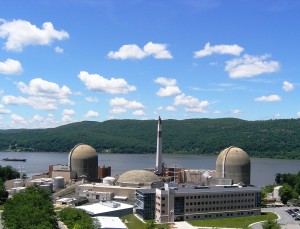Bramson in favor of closing Indian Point
The two candidates running for Westchester County executive are on opposite ends of the argument over whether or not to close Indian Point Energy Center, the Buchanan nuclear power plant.
Democrat Noam Bramson said he is in favor of creating a plan to reduce the county”™s energy consumption, develop alternative power sources and eventually close Indian Point, which has often been criticized for its location on the Hudson River, 25 miles outside of New York City and within 50 miles of the homes of 17 million people.
“A nuclear power plant should never have been sited in an area that”™s so densely populated and which does not have adequate escape routes,” Bramson, who is the mayor of New Rochelle, said during an Oct. 2 debate in White Plains. “But I recognize that”™s not something that can be accomplished overnight and therefore we have to establish this as a longer-term objective.”
But Bramson”™s opponent, incumbent Robert P. Astorino, said he wants to keep open the plant that produces about 25 percent of the electricity for New York City and Westchester. “To say, ”˜Let”™s close it down,”™ and lose 25 percent of our region”™s energy is nonsense,” he said. “I mean that cannot happen, that”™s not reality. We must have clean energy and we do in nuclear power and so yes, I would support the continued operation.”
Entergy Corp., which owns Indian Point, is seeking to relicense the plant”™s two reactors for another 20 years amid ongoing opposition from environmental groups and politicians including Gov. Andrew Cuomo who say the plant is a health risk and a potential terrorist target. The current relicensing is the lengthiest process of its kind in U.S. history. No plant has ever closed due to an expired license.
Supporters have said the region”™s infrastructure couldn”™t meet the area”™s electricity needs if the plant were closed and emissions would increase because more fuel-burning power plants would need to make up the deficit. The Business Council of Westchester, of which Entergy is a member, released a study last year that said closing the power plant would drain $11.5 billion from the local economy, cause electric rates to jump 6.3 percent and increase the likelihood of blackouts by 280 percent.
Indian Point employs about 1,600 with about $130 million in salaries, according to the report, while a similarly sized gas plant would employ about 20 employees. The report also said closing Indian Point would mean a loss of $75 million in annual local property taxes and $2 million to local charities from the plant”™s owners.
That study, itself an update from a 2008 report, was in reaction to 2011 research by Synapse Energy Economics Inc., that said if Indian Point closed the infrastructure could meet the region”™s energy demands and would only minimally affect energy bills, to the tune of roughly an extra $1 per month.
Bramson said in an email to the Business Journal that there is no reason the plant”™s closing, if done over time, should have an impact on the local economy. “In fact, if we pair the gradual decommissioning ”¦ with a strategy to build out our alternative energy infrastructure and promote smart growth and sustainable development, we can seize an opportunity to make broader investments in our county economy.”
Although the federal government has the final say on the operation of any nuclear facility, Bramson said the county executive could be an advocate for residents and local business owners and act as a leader in “green” planning. As mayor of New Rochelle, Bramson oversaw the creation of GreeNR, a sustainability plan which set 43 initiatives over 20 years to increase awareness of environmental impacts, reduce energy consumption and cut costs. “I want to take the same approach countywide,” he said.
The continued operation of the power plant has been a talking point in county executive races in the past. Democrats had accused Astorino of having a tight-knit relationship with Entergy when he first ran for the seat in 2005 against incumbent Andy Spano and lost. In a 2009 rematch, Astorino won despite a 110,000 Democratic-to-Republican registration advantage in the county.
Indian Point first went into operation in 1962. Its original reactor, Indian Point 1, is no longer in use. Indian Point 2 and 3 were added in the 1970s. Indian Point 2”™s permit expired in September, but the NRC extended the old permit until a decision could be made on the relicensing. Unit 3”™s permit expires in December 2015. Bramson said he favors a decommissioning that would not extend operation of the reactors another 20 years, but he does not think the plant should be immediately shuttered.
